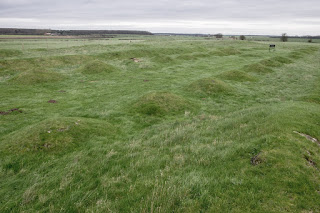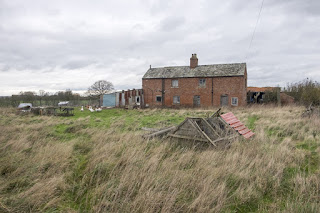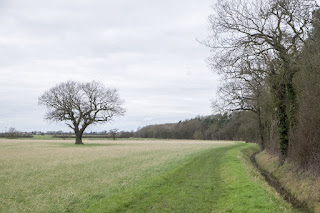Why walk, apart from the fact that I enjoy walking and people in
medieval times and the Middle Ages may well have travelled between the abbeys
and Lincoln on foot? Liz Wells (2011)
reminds us that in the early years of photography, the photographer would
travel on foot to reach his desired location, but during the second half of the
20th century and into the 21st car ownership has become widespread, rail
travel is faster and we have cheap air travel.
Travel has become associated with speed of access. She argues that walking is different, with a
slower pace and an increased experience of the environment. Walking, she points out, is a reflective
experience and all of the senses are brought to bear. She suggests that walking is a whole body
experience and integrates the sensual and the cerebral. Walking is also sequential. Also in favour of walking is Anna Pavord (2016) who argues that speed diminishes the gifts that a journey can give such as moving through a landscape slowly in order to be able to watch it and take in its characteristics. She suggests that she wants to slow down the whole process and stay in touch with moving over the landscape. Pavord (2016) also quotes William Cobbett who reported to the Board of Agriculture in 1821 and said that a coach goes too quickly and you can see nothing; he actually rode, stating that on foot "the fatigue was too great!" For these reasons, as well as a natural
enjoyment of the process, both in my native Lincolnshire and in mountain
environments, I decided to complete this assignment by walking, recording what
I saw during my perambulations.
References and Bibliography
Fulton,H. An Object Cannot Be Complete Without an Experience [colour photograph] [online image] Available from: http://www.clarkgoldsberry.com/uploads/7/4/3/0/7430824/3391149_orig.jpg [Accessed 23.2.16]
Long, R. (1967) A Line Made By Walking [photograph] [online image] Tate. Available from: http://www.tate.org.uk/art/artworks/long-a-line-made-by-walking-ar00142 [Accessed 23.2.16]
MacFarlane, R. (2013) The Old Ways: A Journey on Foot. London. Penguin
I have looked at four photographer artists while researching
this part of my body of work: Richard Long, Hamish Fulton and Paul Gaffney and and Chris Friel. Links
to the relevant blogs are indicated. All
four base their work on walking. Richard Long began his work by photographing
his walks, often the 'footpath' that he had created by walking back and forth
along it. Some of my images of actual paths were taken because of that
inspiration. Long has since expanded his
work to include sculpture both in the land, which he photographs, and in the
studio/gallery and also the use of text.
Unlike Long who alters the landscapes he passes through, Fulton treads
softly and leaves no indication of his passing.
Like Long, however, Fulton began with photography, but gradually text
has taken over more and more. His aim
was to engage with the land and nature and he feels that walking is a
meditative experience. He says that a
walk has a life of its own and does not need to be materialized into an artwork. He also says that an artwork may be
purchased but a walk cannot be sold. Unlike
Richard Long and Hamish Fulton, contemporary photographer Paul Gaffney still
relies totally on his photography. In
fact, he chooses not to add text to his images as he feels that it would
distract the viewer from the photograph and he argues that lack of caption adds
mystery to the pictures. He agrees with Hamish Fulton, though, in that he believes fervently that walking is a meditative experience and part of his PhD work is to develop a process of photography which will help other photographers to combine art and meditation.
Another photographer studied is Chris Friel who makes inspirational ICM images. In an interview by Tim Parkin (2010) he says that one consistent theme in his technique is walking long distances.
Another photographer studied is Chris Friel who makes inspirational ICM images. In an interview by Tim Parkin (2010) he says that one consistent theme in his technique is walking long distances.
Like both Hamish Fulton and Paul Gaffney I have long found walking
(and running) to be a meditative experience, especially in mountain
landscapes. When walking in mountains,
especially when on my own, I have a very strong sensation that I never want to
come down. Walking is very definitely a
very special experience and while taking the photographs for this part of my
body of work it enabled me to meditate on the memories and myths of past ages
that the land and people hold as Simon Schama describes in his book Landscape and Memory.
Bowditch, T and Rochowski, N. (2016) Paul Gaffney Global Archive Photography Available from: http://globalarchivephotography.com/project/paul-gaffney/ [Accessed 23.2.16]
Fulton, H. (1991) Wind Through the Pines [photograph] [online image] Tate. Available from: http://www.tate.org.uk/art/images/work/P/P77/P77621_10.jpg [Accessed 23.2.16]
Deakin, R. (2007) Wildwood, A Journey Through Trees 2nd Edition London Penguin Books Ltd
Gaffney, P. 92016) Paul Gaffney [online] Available from: http://www.paulgaffneyphotography.com/About [Accessed 23.2.16]
MacFarlane, R. (2013) The Old Ways: A Journey on Foot. London. Penguin
Padley, G. (2013) We Make the Path by Walking by Paul Gaffney. British Journal of Photography [online]. Available from: http://www.bjp-online.com/2013/11/we-make-the-path-by-walking-by-paul-gaffney-book-review/ [Accessed 23.2.16]
Parkin,
T. (2010) Chris Friel On Landscape [online]
Available from: https://www.onlandscape.co.uk/2010/12/featured-photographer-chris-friel/
Accessed [10.2.16]
Pavord.A. (2016) Landskipping: Painters, Ploughmen and Places. London. Bloomsbury
Pavord.A. (2016) Landskipping: Painters, Ploughmen and Places. London. Bloomsbury
Turner Contemporary (2012) Hamish Fulton: Walk [online] Available from: https://www.turnercontemporary.org/media/documents/Hamish-Fulton-background-resource.pdf [Accessed 21.02.16]

































































No comments:
Post a Comment